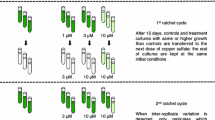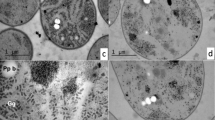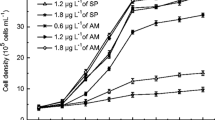Abstract
Adaptation of Microcystis aeruginosa (Cyanobacteria) to resist the herbicide glyphosate was analysed by using an experimental model. Growth of wild-type, glyphosate-sensitive (Gs) cells was inhibited when they were cultured with 120 ppm glyphosate, but after further incubation for several weeks, occasionally the growth of rare cells resistant (Gr) to the herbicide was found. A fluctuation analysis was carried out to distinguish between resistant cells arising from rare spontaneous mutations and resistant cells arising from other mechanisms of adaptation. Resistant cells arose by rare spontaneous mutations prior to the addition of glyphosate, with a rate ranging from 3.1 × 10−7 to 3.6 × 10−7 mutants per cell per generation in two strains of M. aeruginosa; the frequency of the Gr allele ranged from 6.14 × 10−4 to 6.54 × 10−4. The Gr mutants are slightly elliptical in outline, whereas the Gs cells are spherical. Since Gr mutants have a diminished growth rate, they may be maintained in uncontaminated waters as the result of a balance between new resistants arising from spontaneous mutation and resistants eliminated by natural selection. Thus, rare spontaneous pre-selective mutations may allow the survival of M. aeruginosa in glyphosate-polluted waters via Gr clone selection.



Similar content being viewed by others
Abbreviations
- CF:
-
Coefficient of form
- Gr :
-
Glyphosate-resistant cells
- Gs :
-
Glyphosate-sensitive cells
- \( m_{{\text{G}}^{\text{r}} } \) :
-
Malthusian fitness parameter from glyphosate-resistant cells
- \( m_{{\text{G}}^{\text{s}} } \) :
-
Malthusian fitness parameter from glyphosate-sensitive cells
- N 0 :
-
No. of cells at the start of the experiment
- N t :
-
No. of cells at the end of the experiment
- P 0 :
-
Proportion of cultures without Gr cells in the set 1 fluctuation analysis experiment
- q :
-
Frequency of Gr allele in natural, non-exposed to glyphosate populations
- s :
-
Coefficient of selection
- μ :
-
Mutation rate
References
Ayala FJ, Kiger JA Jr (1980) Modern genetics. The Benjamins/Cummings Publishing Company, Menlo Park, CA, USA
Bañares-España E, López-Rodas V, Salgado C, Costas E, Flores-Moya A (2006) Inter-strain variability in the photosynthetic use of inorganic carbon, exemplified by the pH compensation point, in the cyanobacterium Microcystis aeruginosa. Aquat Bot 85:159–162
Baos R, García-Villada L, Agrelo M, López-Rodas V, Hiraldo F, Costas E (2002) Short-term adaptation of microalgae in highly stressful environments: an experimental model analysing the resistance of Scenedesmus intermedius (Chlorophyceae) to the heavy metals mixture from the Aznalcóllar mine spill. Eur J Phycol 37:593–600
Baucom RS, Mauricio R (2004) Fitness costs and benefits of novel herbicide tolerance in a noxious weed. Proc Natl Acad Sci USA 101:13386–13390
Belfiore NM, Anderson SL (2001) Effects of contaminants on genetic patterns in aquatic organisms: a review. Mutat Res 489:97–122
Bradshaw AD, Hardwick K (1989) Evolution and stress—genotype and phenotype components. Biol J Linn Soc 37:137–155
British Standards Institute (1979) Precision of test methods. I. Guide for the determination of repeatability and reproducibility for a standard test method for inter-laboratory tests. BS 5497. Part I. British Standards Institute, London, UK
Cairns J, Overbaugh J, Miller S (1998) The origin of mutants. Nature 335:142–145
Carrillo E, Ferrero LM, Alonso-Andicoberry C, Basanta A, Martín A, López-Rodas V, Costas E (2003) Interstrain variability in toxin production in populations of the cyanobacterium Microcystis aeruginosa from water-supply reservoirs of Andalusia and lagoons of Doñana National Park (southern Spain). Phycologia 42:269–274
Costas E, Carrillo E, Ferrero LM, Agrelo M, García-Villada L, Juste J, López-Rodas V (2001) Mutation of algae from sensitivity to resistance against environmental selective agents: the ecological genetics of Dictyosphaerium chlorelloides (Chlorophyceae) under lethal doses of 3-(3,4-dichlorophenyl)-1,1-dimethylurea herbicide. Phycologia 40:391–398
Coustau C, Chevillon C, Ffrench-Constant R (2000) Resistance to xenobiotics and parasites: can we count the cost? Trends Ecol Evol 15:378–383
Crow JF, Kimura M (1970) An introduction to population genetics theory. Harper and Row, New York, NY, USA
Falkowski PG, Raven JA, (1997) Aquatic photosynthesis. Blackwell Science, Malden, MA, USA
Flores-Moya A, Costas E, Bañares-España E, García-Villada L, Altamirano M, López-Rodas V (2005) Adaptation of Spirogyra insignis (Chlorophyta) to an extreme natural environment (sulphureous waters) through preselective mutations. New Phytol 165:655–661
Foster PL (2000) Adaptive mutation: implications for evolution. BioEssays 22:1067–1074
García-Villada L, López-Rodas V, Bañares-España E, Flores-Moya A, Agrelo M, Martín-Otero L, Costas E (2002) Evolution of microalgae in highly stressing environments: an experimental model analyzing the rapid adaptation of Dictyosphaerium chlorelloides (Chlorophyceae) from sensitivity to resistance against 2,4,6-trinitrotoluene by rare preselective mutations. J Phycol 38:1074–1081
García-Villada L, Rico M, Altamirano M, Sánchez-Martín L, López-Rodas V, Costas E (2004) Occurrence of copper resistant mutants in the toxic cyanobacterium Microcystis aeruginosa: characterization and future implications in the use of copper sulphate as an algaecide. Water Res 38:2207–2213
Goyanes VJ, Ron-Corzo A, Costas E, Maneiro E (1990) Morphometric categorization of human oocyte and early conceptus. Hum Reprod 5:613–618
Huxley J (1942) Evolution: the modern synthesis. Harper, New York, NY, USA
Junghans M, Backhaus T, Faust M, Scholze M, Grimme LH, (2006) Application and validation of approaches for the predictive hazard assessment of realistic pesticide mixtures. Aquat Toxicol 76:93–110
Kirk JTO (1994) Light and photosynthesis in aquatic ecosystems, 2nd edn. Cambridge University Press, New York, NY, USA
Koenig F (2001) Eukaryotic Algae, Cyanobacteria and Pesticides. In: Rai LC, Gaur JP (eds) Algal adaptation to environmental stresses. Physiological, biochemical and molecular mechanisms, Springer, Berlin, Germany, pp 389–406
Lewontin RC, (1974) The genetic basis of evolutionary change. Columbia University Press, New York, NY, USA
López-Rodas V, Agrelo M, Carrillo E, Ferrero LM, Larrauri A, Martín-Otero L, Costas E (2001) Resistance of microalgae to modern water contaminants as the result of rare spontaneous mutations. Eur J Phycol 36:179–190
López-Rodas V, Costas E, Bañares-España E, García-Villada L, Altamirano M, Rico M, Salgado C, Flores-Moya A (2006) Analysis of polygenic traits of Microcystis aeruginosa (Cyanobacteria) strains by Restricted Maximum Likelihood (REML) procedures: 2. Microcystin net production, photosynthesis and respiration. Phycologia 45:243–248
Luria SE, Delbrück M (1943) Mutations of bacteria from virus sensitivity to virus resistance. Genetics 28:491–511
Margulis L, Schwartz KV, (1982) Five kingdoms. An illustrated guide to the phyla of life on earth. W. H. Freeman, San Francisco, CA, USA
Myers N, Knoll AH (2001) The biotic crisis and the future of evolution. Proc Natl Acad Sci USA 98:5389–5392
Palumbi SR (2001) Humans as world’s greatest evolutionary force. Science 293:1786–1790
Renau-Piqueras J, Gómez-Perretta C, Guerri C, Sanchis R (1985) Qualitative and quantitative ultrastructural alterations in hepatocytes of rats prenatally exposed to ethanol with special reference to mitochondria, golgi apparatus and peroxisomes. Virchows Arch 405:237–251
Rico M, Altamirano M, López-Rodas V, Costas E (2006) Analysis of polygenic traits of Microcystis aeruginosa (Cyanobacteria) strains by Restricted Maximum Likelihood (REML) procedures: 1. Size and shape of colonies and cells. Phycologia 45:237–242
Rosche WA, Foster PL, (2000) Determining mutation rates in bacterial populations. Methods 20:4–17
Skulberg OM, Carmichael WW, Codd GA, Skulberg R (1993) Toxigenic cyanophytes identification and taxonomy. In: Falconer IR (ed) Algal toxins in seafood and drinking water, Academic Press, London, pp. 145–164
Sniegowski PD (2005) Linking mutation to adaptation: overcoming stress at the spa. New Phytol. 166:360–362
Sniegowski PD, Lenski RE (1995) Mutation and adaptation: The directed mutation controversy in evolutionary perspective. Annu Rev Ecol Syst 26:553–578
Spiess EB (1989) Genes in Populations, 2nd edn. Wiley, New York, NY, USA
Thrusfield M (1995) Veterinary epidemiology. Blackwell Science, New York, NY, USA
Whitton BA (2002) Phylum Cyanophyta (Blue Green Algae/Cyanobacteria). In: John DJ, Whitton BA, Brook AJ (eds) The freshwater algal flora of the British Isles. An identification guide to freshwater and terrestrial algae. Cambridge University Press, Cambridge, UK, pp 25–122
Williams MA (1977) Quantitative methods in biology. North Holland, Amsterdam, Netherlands
Woodruff DS (2001) Declines of biomes and biotas and the future of evolution. Proc Natl Acad Sci USA 98:5471–5476
Acknowledgements
This work was financially supported by REN 2000-0771 HID, REN 2001-1211 HID, Parques Nacionales 093/2003, P05-RNM-00935 and DOÑANA-2005 grants. Dr. Eric C. Henry (Herbarium, Department of Botany and Plant Pathology, Oregon State University, USA) kindly revised the English style and usage.
Author information
Authors and Affiliations
Corresponding author
Rights and permissions
About this article
Cite this article
López-Rodas, V., Flores-Moya, A., Maneiro, E. et al. Resistance to glyphosate in the cyanobacterium Microcystis aeruginosa as result of pre-selective mutations. Evol Ecol 21, 535–547 (2007). https://doi.org/10.1007/s10682-006-9134-8
Received:
Accepted:
Published:
Issue Date:
DOI: https://doi.org/10.1007/s10682-006-9134-8




